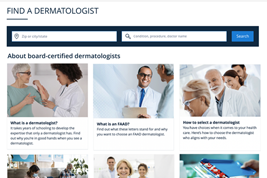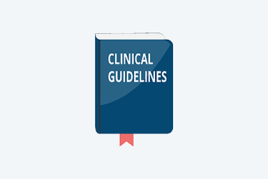Guideline development process
American Academy of Dermatology (AAD) guideline development follows recommendations from the National Academy of Sciences and administrative regulations (PDF) that include a rigorous review and grading of the relevant scientific literature, input of an expert volunteer physician work group, and a multi-layer peer review approval process.
Oversight of these efforts is the responsibility of the Clinical Guidelines Committee (CGC). The Academy continually evaluates and, if necessary, modifies its development processes to respond to new challenges in an effort to produce timely and informative guidance for its members, while maintaining an integral evidence-based structure.
The AAD is mindful of the potential for conflicts of interest (COI) to influence guideline content and has developed a COI policy specific to those who participate in the development process.
Below is a summary of the steps in the AAD guideline development process.

Guideline topics
Topics are chosen in part for their timeliness for informing decision making.
1. Identify and select guideline topics: Guideline topics are identified through a needs assessment process involving input from representatives of several Academy councils, committees, and task forces. AAD members are encouraged to submit guideline topics for consideration. Evaluation and prioritization of topics is facilitated by review of several criteria:
Degree of public health importance (high prevalence, significant morbidity)
Perceived or documented variation in practice patterns
Potential for performance measure and CCP module development
Timeliness of topic for informing and improving provider decision making
Availability and strength/quality of evidence to produce clinical recommendations
Area addresses multiple aspects of dermatology practice scope
An area in which increased dermatologic attention and involvement would be helpful for the specialty
Relevancy to Medicare and Medicaid programs
Relevancy to managed care programs
Availability of interventions with high societal or economic cost
2. Identify experts and form work groups: Once a guideline topic has been approved by the board, the work group chair(s) and members are identified and appointed after a thorough consideration of clinical expertise and potential conflicts of interest. Academy members who wish to serve on a guideline work group may submit their names for consideration.
3. Determine guideline scope and clinical questions for literature review: Academy guidelines may be developed in one of three possible scopes (broad, targeted, or narrow) depending on the selected topic, and may address one or more clinical questions. These questions serve as the basis for the literature retrieval and critical review of identified publications.
4. Develop clinical recommendations and guideline text: The best available evidence to be used in support of clinical recommendations is graded, allowing for the strength/quality of the evidence and the strength of the recommendation to be determined. These recommendations facilitate the drafting of supporting guideline text.
5. Review, comment, and approval process: Once the work group has completed and approved a draft guideline, it moves on to an extensive review, comment, and approval process, which includes the following:
Clinical Guidelines Committee (CGC)
AAD Members
Council on Science and Research
Board of Directors
At each stage, solicited feedback is considered for incorporation into the guideline, or revision of the guideline, as supported by the available evidence and the expert clinical judgment of the work group. This review process also is used to screen for any potential conflict of interest. Approvals from the Clinical Guidelines Committee and the Council on Science and Research are required prior to submission of the draft guideline to the Board of Directors.
6. JAAD publication: Following approval of the guideline by the board, the text is submitted to JAAD for publication consideration, where it follows the JAAD manuscript review process for acceptance.
7. Periodic review: Guidelines are reaffirmed, updated, or sunset at least every five years based on a review of new evidence that could affect the guideline's recommendations.
 Find a Dermatologist
Find a Dermatologist
 Member directory
Member directory
 AAD Learning Center
AAD Learning Center
 2026 AAD Annual Meeting
2026 AAD Annual Meeting
 Need coding help?
Need coding help?
 Reduce burdens
Reduce burdens
 Clinical guidelines
Clinical guidelines
 Why use AAD measures?
Why use AAD measures?
 Latest news
Latest news
 New insights
New insights
 Physician wellness
Physician wellness
 Joining or selling a practice?
Joining or selling a practice?
 Promote the specialty
Promote the specialty
 Advocacy priorities
Advocacy priorities
